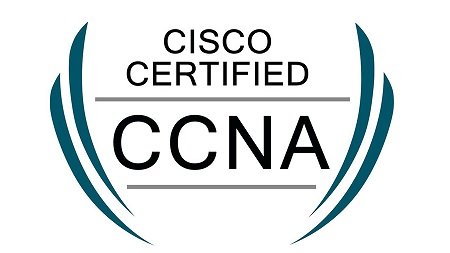Module 1:
Compare and contrast OSI and TCP/IP models
Module 2:
Compare and contrast TCP and UDP protocols
Module 3:
Describe the impact of infrastructure components in an enterprise network
Module 4:
Firewalls Access points Wireless controllers Describe the effects of cloud resources on enterprise network architecture
Module 5:
Traffic path to internal and external cloud services Virtual services Basic virtual network infrastructure Compare and contrast collapsed core and three-tier architectures
Module 6:
Compare and contrast network topologies
Module 7:
Mesh Hybrid Select the appropriate cabling type based on implementation requirements
Module 8:
Apply troubleshooting methodologies to resolve problems
Module 9:
Perform and document fault isolation Resolve or escalate Verify and monitor resolution Configure, verify, and troubleshoot IPv4 addressing and subnetting
Module 10:
Compare and contrast IPv4 address types
Module 11:
Unicast Broadcast Multicast Describe the need for private IPv4 addressing
Module 12:
Identify the appropriate IPv6 addressing scheme to satisfy addressing requirements in a LAN/WAN environment
Module 13:
Configure, verify, and troubleshoot IPv6 addressing
Module 14:
Configure and verify IPv6 Stateless Address Auto Configuration
Module 15:
Compare and contrast IPv6 address types
Module 16:
Global unicast Unique local Link local Multicast Modified EUI 64 Autoconfiguration Anycast LAN Switching Technologies Describe and verify switching concepts
Module 17:
MAC learning and aging Frame switching Frame flooding MAC address tab
Module 18:
Interpret Ethernet frame format
Module 19:
Troubleshoot interface and cable issues (collisions, errors, duplex, speed)
Module 20:
Configure, verify, and troubleshoot VLANs (normal/extended range) spanning multiple switches
Module 21:
Access ports (data and voice) Default VLAN Configure, verify, and troubleshoot interswitch connectivity
Module 22:
Trunk ports add and remove VLANs on a trunk DTP, VTP (v1&v2), and 802.1Q Native VLAN Configure, verify, and troubleshoot STP protocols
Module 23:
STP mode (PVST+ and RPVST+) STP root bridge selection Configure, verify and troubleshoot STP related optional features
Module 24:
PortFast BPDU guard
Module 25:
Configure and verify Layer 2 protocols
Module 26:
Cisco Discovery Protocol LLDP Configure, verify, and troubleshoot (Layer 2/Layer 3) EtherChannel
Module 27:
Static PAGP LACP Describe the benefits of switch stacking and chassis aggregation
Module 28:
Routing Technologies Describe the routing concepts
Module 29:
Packet handling along the path through a network Forwarding decision based on route lookup Frame rewrite Interpret the components of a routing table
Module 31:
Network mask Next hop Routing protocol code Administrative distance Metric Gateway of last resort Describe how a routing table is populated by different routing information sources
Module 32:
Admin distance Configure, verify, and troubleshoot inter-VLAN routing
Module 33:
Router on a stick SVI Compare and contrast static routing and dynamic routing
Module 34:
Compare and contrast distance vector and link state routing protocols
Module 35:
Compare and contrast interior and exterior routing protocols
Module 36:
Configure, verify, and troubleshoot IPv4 and IPv6 static routing
Module 37:
Default route Network route Host route Floating static Configure, verify, and troubleshoot single area and multi-area OSPFv2 for IPv4 (excluding authentication, filtering, manual summarization, redistribution, stub, virtual-link, and LSAs)
Module 38:
Configure, verify, and troubleshoot single area and multi-area OSPFv3 for IPv6 (excluding authentication, filtering, manual summarization, redistribution, stub, virtual-link, and LSAs)
Module 39:
Configure, verify, and troubleshoot EIGRP for IPv4 (excluding authentication, filtering, manual summarization, redistribution, stub)
Module 40:
Configure, verify, and troubleshoot EIGRP for IPv6 (excluding authentication, filtering, manual summarization, redistribution, stub)
Module 41:
Configure, verify, and troubleshoot RIPv2 for IPv4 (excluding authentication, filtering, manual summarization, redistribution)
Module 42:
Troubleshoot basic Layer 3 end-to-end connectivity issues
Module 43:
WAN Technologies Configure and verify PPP and MLPPP on WAN interfaces using local authentication
Module 44:
Configure, verify, and troubleshoot PPPoE client-side interfaces using local authentication
Module 45:
Configure, verify, and troubleshoot GRE tunnel connectivity
Module 46:
Describe WAN topology options
Module 47:
Point-to-point Hub and spoke Full mesh Single vs dual-homed Describe WAN access connectivity options
Module 48:
MPLS Metro Ethernet Broadband PPPOE Internet VPN (DMVPN, site-to-site VPN, client VPN) Configure and verify single-homed branch connectivity using eBGP IPv4 (limited to peering and route advertisement using Network command only)
Module 49:
Describe basic QoS concepts
Module 50:
Marking Device trust Prioritization Voice Video Data Shaping Policing Congestion management Infrastructure Services Describe DNS lookup operation
Module 51:
Troubleshoot client connectivity issues involving DNS
Module 52:
Configure and verify DHCP on a router (excluding static reservations)
Module 53:
Server Relay Client TFTP, DNS, and gateway options Troubleshoot client- and router-based DHCP connectivity issues
Module 54:
Configure, verify, and troubleshoot basic HSRP
Module 55:
Priority Preemption Version Configure, verify, and troubleshoot inside source NAT
Module 56:
Static Pool PAT Configure and verify NTP operating in a client/server mode
Module 57:
Infrastructure Security Configure, verify, and troubleshoot port security Static Dynamic Sticky Max MAC addresses Violation actions Err-disable recovery Describe common access layer threat mitigation techniques
Module 58:
802.1x DHCP snooping Nondefault native VLAN Configure, verify, and troubleshoot IPv4 and IPv6 access list for traffic filtering
Module 59:
Standard Extended Named Verify ACLs using the APIC-EM Path Trace ACL analysis tool
Module 60:
Configure, verify, and troubleshoot basic device hardening
Module 61:
Local authentication Secure password Access to device Source address Telnet/SSH Login banner Describe device security using AAA with TACACS+ and RADIUS
Module 62:
Static Pool PAT Configure and verify NTP operating in a client/server mode
Module 63:
Infrastructure Management Configure and verify device-monitoring protocols
Module 64:
SNMPv2 SNMPv3 Syslog Troubleshoot network connectivity issues using ICMP echo-based IP SLA
Module 65:
Configure and verify device management
Module 66:
Backup and restore device configuration Using Cisco Discovery Protocol or LLDP for device discovery Licensing Logging Timezone Loopback Configure and verify initial device configuration
Module 67:
Perform device maintenance
Module 68:
Cisco IOS upgrades and recovery (SCP, FTP, TFTP, and MD5 verify) Password recovery and configuration register File system management Use Cisco IOS tools to troubleshoot and resolve problems
Module 69:
Ping and traceroute with extended option Terminal monitor Log events Local SPAN Describe network programmability in enterprise network architecture
Module 70:
Function of a controller Separation of control plane and data plane Northbound and southbound APIs






